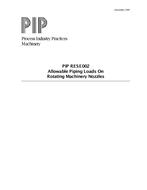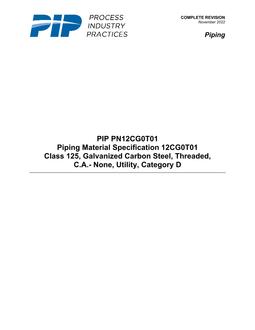
PIP RESE002
Click here to purchase
The purpose of this Practice is to provide requirements for reducing the total life cycle costs of rotating machinery by determining allowable piping loads and piping load application to rotating machinery.
Comment: User experience has shown that designing for the maximum published allowable loads for most machinery results in low Mean Time Between Repair (MTBR) and higher than acceptable maintenance costs.
It is the intent of this Practice to:
Limit the application of the entire maximum allowable nozzle load during the equipment installation design, allowing some reserve margin to maximize the possibility of the final installation actually remaining within the allowable loading.
Begin driving the stated, published and calculated allowable nozzle loads to become more performance based, tied more closely to actual effects on the MTBR and Life Cycle Costs for the machinery in order to:
Promote the highest reliability for Vital or Sensitive machinery and the determination of those allowable loads that will allow the achievement of that reliability
Allow spared (essential) machinery to be more heavily loaded, and encourage manufacturers to either furnish allowable load data or comply with a published standard
Encourage machinery manufacturers to generate more meaningful reliability based allowable nozzle load recommendations
Encourage standards organizations to look at the basis for their allowable load values/calculation methods and verify the effects on the demonstrated MTBR and Life Cycle Costs
This Practice covers requirements for calculating allowable piping loads and the application of those loads for rotating machinery in the process industries. This Practice also provides requirements for minimizing loads imposed on equipment by the piping systems.
Comment: This Practice is intended to apply to rotating machinery including pumps and compressors (centrifugal, reciprocating and rotary screw), steam and gas turbines, liquid ring compressors, and also may be used after consultation with the manufacturer on fans and blowers.
Product Details
- Published:
- 12/01/1997
- File Size:
- 1 file , 69 KB

